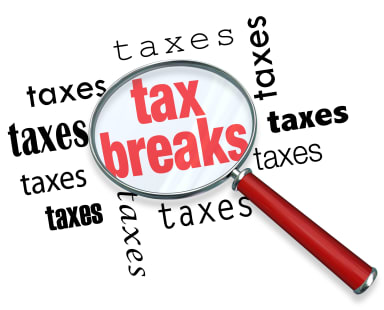Are you missing out on tax deductions you are entitled to? Many small business owners overpay their taxes because they don’t know what expenses they can deduct. Others miss legitimate deductions because they lose receipts, don’t keep adequate records, or ignore small tax-deductible charges that seem inconsequential.
Don’t let missed tax deductions cause you to overpay the IRS. This list of the top small business tax deductions will help you keep more of your hard-earned profits.
1 – Business Use of Your Vehicle
This is a deduction some self-employed lose out on because recording business mileage – especially for short drives – can seem like a hassle. But even short, local business trips can add up to a significant mileage deduction at the end of the year, if you track them.
As a business owner, if you use a car in your business, you can deduct the car expenses on your tax return. If you use the vehicle for both personal and business use, the deduction is based on the percent of business miles driven.
There are two methods for determining the amount of the deduction. One requires keeping detailed records of the actual expenses. Those expenses include costs such as gas and oil purchase, repair costs, insurance, registration fees and lease payments.
The other, simpler option, is to use the standard mileage deduction. Under this option, you multiply your business mileage for the year by the standard mileage rate. For 2022, that rate was 58.5 cents a mile for miles driven through June, and 62.5 cents per mile for mileage from July through the end of the year. The rate is set to remain at 62.5 cents a mile for 2023.
The sticking point: you have to record the mileage each time you drive for business along with the reason for the trip. But doing so pays off. Here’s how.
Suppose you have a home business selling products. You drive to the post office 6 days a week to mail out your customers’ orders. The post office is 6 miles roundtrip from your home. That’s 36 miles a week. If you work 50 weeks a year, that adds up to 1800 miles. You drove half the mileage in the first half of 2022, and the other 900 miles in the second half of the year. At the mileage rates in effect for 2022, that adds up to a deduction of $1089 for 2022. (It would be $1,125 in 2023 at the 62.5 cent rate for the entire year.)
Do you do a lot of driving to visit clients or suppliers, or to go to networking meetings? That mileage adds up, too. If you drive an average of 100 miles a week for 50 weeks, and record the mileage, you’d wind up with a mileage deduction of $3,025 for 2022. ($1,462.50 for the first half of the year and $1,562.50 for the second half.) For 2023, it would be $3,125.
In addition, you can deduct the business part of interest on your car loan, state and local personal property tax on the car, parking fees, and tolls.
2 – Travel Expenses
Travel costs are different from the expenses you can deduct for the business use of your car. Travel expense deductions are for costs you incur when you travel away from the general area of your tax home. The travel must be longer than an ordinary workday and long enough that you need sleep or rest. The expenses have to be ordinary and necessary for your business, not lavish or extravagant.
Among the expenses you can deduct are:
- Travel by airplane, train, bus or car between your home and your business destination
- Fares for taxis or other types of transportation costs directly related to business
- Shipping or baggage costs
- Lodging and non-entertainment-related meals
- Dry cleaning and laundry
- Business calls while on your business trip
- Tips you pay for services related to any of these expenses
The deduction for meals is usually limited to 50% of what you spend. But for 2021 and 2022, you can deduct the entire cost of meals when you’re traveling when you buy them from a restaurant.
The biggest costs such as plane fares and hotel costs are easy to remember at tax time. But what’s easy to forget or lose are records of cab fares, tips and other incidental expenses. Those can add up, so don’t forget to record them while away.
Want to sneak in a visit to your brother while you’re on a business trip? Or perhaps a day in the sun, if your business trip takes you to Southern California in the winter? Your personal costs, extra day in the hotel, extra day car rental, etc. are not deductible. But the rest of your business costs, including the plane fare to get to the business destination are probably still deductible. The deciding factor: was the primary motive for the trip business?
Most business travel within the United States is likely to qualify for the travel expense deduction as long as it is necessary for your business. Rules vary for travel out of the country, so be sure to check with your accountant or other tax professional for details.
3 – Business Meals When You’re Not Traveling
Does your business require you to wine and dine clients? Do you have a company barbeque or order. Normally, you can deduct 50% of the cost if you or an employee was present at the meal. But for 2021 and 2022, if the meal was at a restaurant or provided by a restaurant, you can deduct 100% of the cost.
4 – Interest and Credit Card Processing Fees
Making money has a way of costing money. If you take out a business loan, let business credit card balances run up, or engage in other types of borrowing, you pay interest. And when you accept credit cards either directly or through a third party, you pay a fee. Those fees and interest payments can be substantial. Fortunately, they are tax deductible. Be sure to record them and deduct them.
5 – Business Subscriptions
Chances are, subscriptions for cloud-based services are among your regular business expenses. Depending on your business, your subscriptions may include collections of programs (like Microsoft Office 365 or Adobe Cloud) or individual programs. You might have subscriptions to photo licensing sites, workflow services, SEO tools or video conferencing software. And then, of course, there’s the hosting fee you pay for your website.
All of these, along with any other products or services you subscribe to for use in your business are deductible.
6 – Consulting and Professional Fees
The fees your business pays to accountants and attorneys, consultants and coaches are all deductible expenses.
7 – Educational Costs
Want to learn how to use an accounting program to manage the finances of the business you just started? How about learning how to use WordPress so you can update your business website, or build a new one? No matter what you want to learn, there’s a good chance you can find a course about the subject. As a business owner, the cost of taking those courses is tax deductible to you as long as the courses maintain or improve the skills you need for your existing business. (You can’t deduct the cost of training for a new business.)
8 – Startup Costs and Organizational Expenses
Did you just start your business?
Most business tax deductions apply to expenses you incur after your business is up and running. But chances are you incurred expenses as you were preparing to launch your business. Depending on the amount of those costs, some or all of them may be immediately deductible if they are incurred in the year you start the business. Here’s how it works.
The IRS currently allows you to deduct up to $5,000 in qualifying business startup and $5,000 in organizational expenses in the year you start the business if your total startup expenses are $50,000 or less. If your startup expenses exceed $50,000, the amount you can deduct in the first year by the amount your total start-up or organizational costs exceed $50,000. For example, if your total startup costs are $53,000 you can only deduct $2,000 in startup costs. Startup costs that you can’t deduct in the first year can be depreciated over a period of 180 months.
Startup costs that qualify are those you incur before you open your doors for business. They include money you spend on market research, advertisements for opening the business, consulting and other professional fees, salaries and training costs paid to employees before you open the business, and other expenses related to obtaining suppliers, distributors and customers.
Organizational expenses refer to the money you spend to legally form your corporation, LLC or partnership. The IRS currently allows you to deduct up to $5,000 in business startup and $5,000 in organizational expenses in the year you start the business if your total startup expenses are $50,000 or less. If your startup costs are higher than that you can amortize them (deduct them over a period of years).
9 – Rent and Utilities for Businesses that aren’t Homebased
If you rent space for your business, the rental fee is deductible. So, too are the cost of utilities, fees for maintaining common spaces any fees you pay your attorney to review the lease before signing it.
10 – Home Office Deduction
If your home is your principal place of business and the space you use qualifies, you can take a deduction for some expenses related to the space you use. This deduction is called the home office deductions and it’s separate from other deductions you get for expenses associated with actively running the business.
This is another case where the IRS provides two choices for taking the home office deduction. An easy way and a “regular” way, which is more complex.
The easy way is called the simplified option. To take it, you multiply the square footage of your home office by $5.00. The most you can write off each year using this method is $1,500 (300 square feet). Using this method, you take the deduction directly on Schedule C.
To use the regular way to deduct your home business, you’ll need to keep records of expenses such as mortgage or rent payments, real estate taxes, utilities and casualty losses and allocate the costs based on your percentage of business and personal use. You’ll also need to fill out an additional tax form, form 8829.
11 – Internet and Phone Costs
The cost of using the Internet in your business is deductible. If you use your home Internet connection or home phone line for business, your deduction is limited to the percent you use each in business vs for home use. If you have a separate Internet connection for your business and/or a second phone line just for your business, each is fully deductible.
The same rule applies to cell phone use for business owners and the self-employed.
12 – Business Insurance
Insurance may not be something that’s top of mind when you’re getting ready to do your taxes. But business insurance is a relatively big expense, and it’s tax deductible. Whether you work from home or some other location, be sure you deduct the cost of all the business insurance you’ve purchased during the year. Among the policies you may have are a business owners policy (general liability), product liability, professional liability, commercial vehicle insurance. Be sure to deduct them all.
13 – Office Furniture
Did you buy a new desk or desk chair for your home office this year? If you have a business outside of your home, did you have to replace or buy new furniture for the reception area, buy sneeze guards to put between workstations or purchase other workplace furniture?
The money you spend on business furniture can be written off whether it’s for a homebased business or a business that’s located outside the home. Business furniture, like equipment, is considered a capital expense rather than a cost of doing business. And there are two options for deducting the cost:
1 – Depending on the total amount of your capital expenses, you can deduct the entire cost of the furniture in one year. This is often referred to as the expense deduction or the 179 deduction.
2 – You can choose to amortize the expense (spread it out) over a period of years.
The maximum amount of capital expenses you can deduct in one year is $1,050,000 in equipment for tax year 2021. That goes up to $1,080,000 for the 2022 tax year.
One limitation to keep in mind: Your expense deduction can’t be more than you net income from the business. If your capital expenses are higher than your net income talk to a tax pro about the best way to handle them.
14 – Equipment and Software
Equipment and software you purchase, rather than lease or subscribe to are also considered capital expenses. Like office furniture, they can either be expensed (written off) in one year, or depreciated over time.
If you run a home business and the equipment is used exclusively for your business, you can deduct or depreciate the full cost. If you use equipment such as a computer, printer, or camera partly for business and partly for personal use, your deduction is limited to the percent of the time you use the item for business. For devices you use for personal and business use, keep a written record of the business use so you can prove the deduction if you’re ever audited.
15 – Qualified Business Income Deduction (QBI)
The QBI deduction allows eligible taxpayers to deduct up to 20 percent of their qualified business income (QBI), plus 20 percent of qualified real estate investment trust (REIT) dividends and qualified publicly traded partnership (PTP) income.
To qualify, the business must be located inside the U. S. and make a profit. The deduction is limited to taxpayers who have a total income (business income plus any other personal income) of no more than $164,900 for single taxpayers or $329,800 for couples filing jointly.
Additionally, certain types of businesses such as accounting firms, legal firms, consulting and financial services do not qualify for this deduction. The rules are complicated, so this, too, is something to discuss with your tax professional.
16 – Self-Employment Tax Deduction
Self-employment tax is an expense. But there’s a flip side. There’s also a self-employment tax deduction for businesses owners who are self-employed or are LLCs operating as sole proprietors. The way it works: you calculate and pay the self-employment tax on your entire income using schedule SE. But then, you get to deduct half of the self-employment tax on your personal tax return (Form 1040, Schedule 1).
17 – Employee Expense
If you have employees, their salaries and the payroll taxes you pay are deductible. If you’re using a payroll service, their fees are deductible too.
18 – Business Loss Deduction
If you are operating as a sole proprietor and your business expenses are more than your income for the year, you can deduct your business losses from other personal income you have, provided the IRS doesn’t consider your business to be a hobby. If you are operating as an S corp, the amount of losses you can deduct will depend on your basis in the business. Talk to an accounting professional for more information.
19 – Other Normal Business Expenses
Other products and services that you buy to use in your business are deductible, too. The laser toner, printer ink cartridges, paperclips, headphones, and all the expenses you incur are deductible if they are ordinary and necessary. Keep good records and receipts to deduct them on your returns.
Disclaimer: The content on this page is for informational purposes only, and does not constitute legal, tax, or accounting advice. If you have specific questions about any of these topics, seek the counsel of a licensed professional.
Related Posts
- Starting a Business for Tax Purposes: Save Money with Tax Write Offs If you start a small business you could pay substantially fewer taxes on your family’s…
- 5 Top Tips When Starting a Mobile or Remote Business So many businesses these days are conducted away from a dedicated place of work. Set-ups…
Tax Information and Resources







